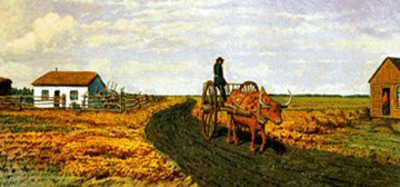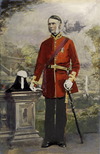- From the Red River Settlement to Manitoba (1812—70)
- Maps
- The Earl of Selkirk: The Colony’s Founder
- An Arduous Task, Marked by a Private War (1812—21)
- The Métis
- Indigenous Peoples
- Colonial Administration
- Maintaining Order and the Colony’s Defence
- Of Fur and Wheat: Subsistence and the Economy
- From Canoes to Railways: Transportation
- Life in Red River
- Missions and Religious Life
- Education, Health, and Social Assistance
- Arts and Culture
- The Press
- Intellectual and Scientific Life
- Winnipeg: The Emergence of an Urban Core
- Debating the Status of the Colony (1850—70)
- The Red River Rebellion and the Creation of Manitoba, 1869—70
- Suggested Readings on the Métis
Of Fur and Wheat: Subsistence and the Economy

Source: Link
Beginning in the 1820s several residents of Red River, including the elder Louis RIEL, a farmer, miller, and Métis leader, tried to end the monopoly on trade in the colony held by the Hudson’s Bay Company (HBC). Their efforts were rewarded in 1849 after a lawsuit was brought against Pierre-Guillaume SAYER for illegal fur trading:
“The jury returned a verdict of guilty but recommended mercy on the ground that Sayer had genuinely believed that the Métis were permitted to trade freely. [John] Ballenden accepted the recommendation and Sayer was freed. [Louis] Riel [Sr] promptly asserted that the verdict was tantamount to a surrender of the HBC monopoly. This view was at once taken up by the Métis assembled outside the court-house, who cried ‘Le commerce est libre!’ So it was to be: the HBC abandoned its efforts to maintain a monopoly and began aggressive competition with the free traders. Sayer’s trial was thus a landmark in the history of the Canadian west.”
Bishop Joseph-Norbert PROVENCHER became deeply involved in the development of the colony, especially in improving agriculture:
“To assist settlers, Provencher encouraged cultivation of the land and cattle raising, and saw that seed and livestock were brought in from Lower Canada and the United States. He set up an ‘industrial school’ for weaving in 1838 to use wool from the sheep brought into the colony, and from the buffalo.”
Consult biographies in the lists below to learn more about different aspects of the colony’s economic development between 1812 and 1870.





